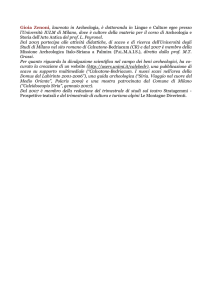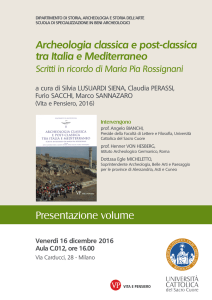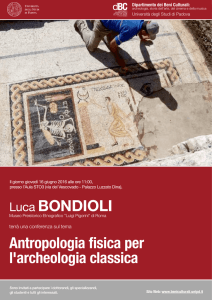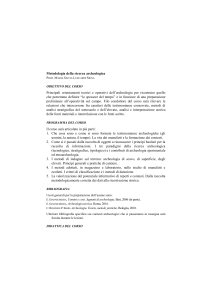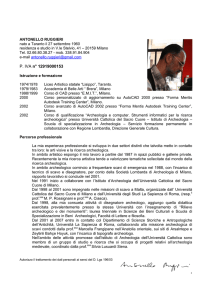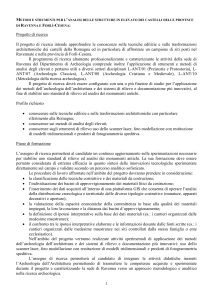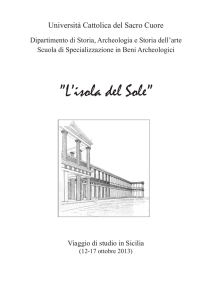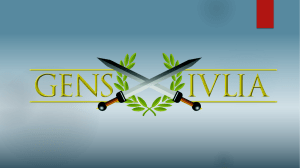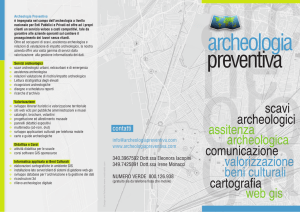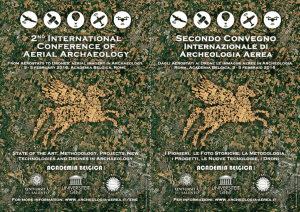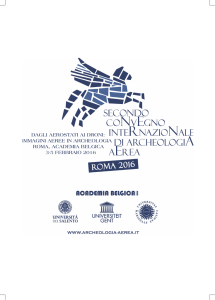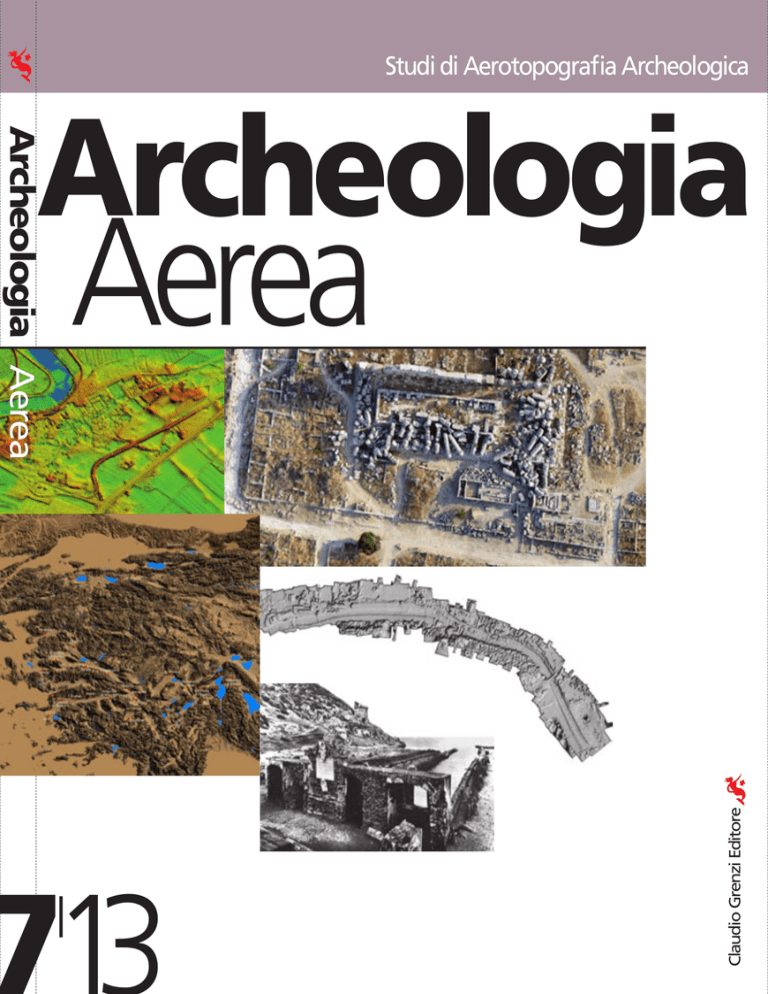
Studi di Aerotopografia Archeologica
Archeologia Aerea
Archeologia
I
Claudio Grenzi Editore
Aerea
Studi di Aerotopografia Archeologica
Archeologia
Aerea7
I13
a cura di
Giuseppe Ceraudo
Claudio Grenzi Editore
Volume edito con il contributo di
Università del Salento. Lecce
Dipartimento di Beni Culturali
Il presente progetto è finanziato con il
sostegno della Commissione europea.
L’autore è il solo responsabile di questa
pubblicazione e la Commissione declina ogni
responsabilità sull’uso che potrà essere fatto
delle informazioni in essa contenute.
Si ringrazia per la collaborazione
FlyTop
“Archeologia Aerea. Studi di Aerotopografia Archeologica” è una Rivista Internazionale
fondata nel 2004 da Giuseppe Ceraudo e Fabio Piccarreta.
Dotata di referees anonimi (peer-reviewed ), raccoglie studi e ricerche di archeologia basati sull’ampio utilizzo di fotografie aeree, immagini satellitari e dati telerilevati in genere.
L’opera – unica nel suo genere in Italia – segue la disciplina sin dai suoi esordi e, passando attraverso contributi di meto­dologia e applicazioni di fotointerpretazione archeologica
e fotogrammetria finalizzata, giunge sino alle modernissime applicazioni specialistiche
legate alle nuove tecnologie di remote sensing e fotointerpretazione satellitare.
Ampio spazio è assegnato nella Rivista agli studi sui pionieri o sull’attività pionieristica
legata alle riprese aeree, allo studio del materiale aerofotografico storico, ai lavori di foto­
interpretazione archeologica classica di respiro internazionale, ai progetti di archeologia
aerea avviati di recente in Italia e nel Mondo, nonché alle attività e allo stato dell’arte
della materia e alle prospettive future di ricerca legate alle immagini telerilevate da piattaforma aerea e satellitare.
La Rivista si propone di presentare l’Aerotopografia Archeologica – disciplina che utilizza a fondo lo strumento aereo e tutte le immagini aerorilevate con le sue varie applicazioni ed elaborazioni – come una parte fondamentale di una materia, la Topografia
Antica, che affonda le sue radici storiche molto indietro nel tempo.
Studi di Aerotopografia Archeologica
Archeologia
Aerea7 13
I
Direzione scientifica
Giuseppe Ceraudo
Comitato scientifico
Progetto grafico
Claudio Grenzi
Robert Bewley (Heritage Lottery Fund - Inghilterra)
Stefano Campana (Università di Cambridge - Inghilterra)
Giuseppe Ceraudo (Università del Salento - Italia)
Michael Doneus (Università di Vienna - Austria)
Darja Grosman (Università di Lubiana - Slovenia)
Piero Alfredo Gianfrotta (Università della Tuscia - Italia)
Marcello Guaitoli (Università del Salento - Italia)
Fabio Piccarreta (Membro onorario)
Stefania Quilici Gigli (Seconda Università di Napoli - Italia)
Wlodek Rączkowski (Università di Poznań - Polonia)
Giuseppe Scardozzi (CNR IBAM - Italia)
Elizabeth Jane Shepherd (ICCD Aerofototeca Nazionale - MiBAC Italia)
Frank Vermeulen (Università di Ghent - Belgio)
Redazione
Paola Carfora, Laura Castrianni, Immacolata Ditaranto,
Veronica Ferrari, Chris Musson, Giorgio Franco Pocobelli
ISBN 978-88-8431-550-2
ISSN 2035-7540
© 2013 Claudio Grenzi Editore
Tutti i diritti riservati.
Nessuna parte di questa pubblicazione
può essere tradotta, ristampata o riprodotta,
in tutto o in parte, con qualsiasi mezzo, elettronico,
meccanico, fotocopie, film, diapositive o altro
senza autorizzazione dell’Editore.
Printed in Italy
Claudio Grenzi sas
Via Le Maestre, 71 · 71121 Foggia
[email protected]
www.claudiogrenzi.it
Recapiti di redazione
Giuseppe Ceraudo
Università del Salento – Dipartimento di Beni Culturali
Laboratorio di Topografia Antica e Fotogrammetria
Via Dalmazio Birago, 64 - 73100 Lecce
Tel. 0832-295513/14
[email protected]
3
Sommario
5 Introduzione
Giuseppe Ceraudo
76 What kind of gaps? Some approaches
to understanding bias in remote
sensing data
David C. Cowley
7 Abstracts
Chris Musson
89 Il cielo sopra Mariana
Aviatori e archeologi alla scoperta di
una colonia romana in Corsica
Studi e ricerche 7.13
Studies and Researches 7.13
Cristina Corsi
104 Il contributo delle immagini satellitari
13 PRONAO
PROgetto Nuovo Atlante di Ostia antica
Giuseppe Ceraudo
18 Aerofotogrammetria, ricostruzione
tridimensionale e rappresentazione
cartografica del paesaggio mediante
ricognizione con velivolo ultraleggero
Il caso di studio del Porto Canale di Paola
al Circeo
Diego Ronchi, Gianluca Casagrande
‘storiche’ alla ricerca archeologica
in Africa settentrionale
Esempi da Tunisia e Libia
Laura Castrianni, Giuseppe Scardozzi
124 Antiche divisioni agrarie in Asia Minore:
problematiche e strumenti di ricerca
Giuseppe Scardozzi
149 The ArchaeoLandscapes Europe Project
September 2010 to October 2013
Chris Musson, Axel Posluschny
33 Archeologia del paesaggio nella valle
del Misa (Marche, Italia)
Nuovi dati sulla città romana di Ostra
dalle ricognizioni aeree e dall’analisi
aerotopografica
157 Tecnologie UAV per il rilievo a bassa quota
in archeologia
Debora Caldarelli, Francesca Ceccaroni
Federica Boschi, Michele Silani
44 La via Appia tra Ponte Rotto ed Aeclanum
Sandra Lo Pilato
53 Aerotopografia e fotogrammetria
finalizzata per la carta archeologica
di Aeclanum
Immacolata Ditaranto
65 Il tracciato della via Traiana al confine
tra Puglia e Campania
Veronica Ferrari
71 L’archeologia preventiva per la
conoscenza della centuriazione
tra Foggia e Troia
Saggi di scavo in località Colle di Postanuova
(Troia, Foggia)
Francesco Rossi
165 I droni per l’archeologia
Fulvio Bernardini
A Fabio Piccarreta,
Maestro della Disciplina,
per il suo 70° compleanno.
5
Introduzione
Nonostante alcuni recenti tentativi di mettere in discussione le potenzialità dell’utilizzo delle immagini aero-rilevate negli studi archeologici del territorio (v. Archeologia
Aerea, 4/5 2010-2011, pp. 5-15), la validità di questo strumento resta, oggi come in
passato, fondamentale. Il ricorso alla fotografia aerea, in funzione dell’analisi e della
conoscenza dei beni archeologici, ha ormai alle spalle una consistente e documentata
tradizione ed è da continuare a considerare uno strumento imprescindibile nell’analisi
del territorio; evidenziando grandi “qualità” diagnostiche nell’ambito dell’oramai dilagante “archeologia preventiva” e notevole potenziale informativo nella ricostruzione dei
paesaggi antichi.
Rinunciare a priori all’utilizzo delle immagini aeree sarebbe un’auto-limitazione della
ricerca; questa risorsa resterà sempre e comunque strumento fondamentale, se non altro
perché conserva memoria storica di un paesaggio che in molti casi non esiste più; le
foto aeree, in particolar modo quelle storiche, possono costituire un bene prezioso, perché potenzialmente costituiscono un archivio formidabile di dati contenuti dal territorio che in molti casi, soprattutto in questi ultimi decenni, abbiamo perso.
La materia ha avuto in questi ultimi tempi un incremento notevole grazie a nuovi dispositivi quali gli Aeromobili a Pilotaggio Remoto (APR o UAV, più comunemente,
droni 1) e sta sperimentando nuove applicazioni e nuovi campi d’indagine, oggi in piena espansione, con potenzialità enormi ancora non ben valutate anche da parte di molti degli addetti ai lavori.
Il mercato mette a disposizione del pubblico diverse tipologie di droni (e la tecnologia
consentirà in tempi rapidi ulteriori passi in avanti) adatti a soddisfare le esigenze di chi
opera nel settore.
Dai primi velivoli più specificatamente orientati al rilievo fotogrammetrico si è passati
oggi a soddisfare molteplici ambiti applicativi, come ad esempio la fotogrammetria, la
topografia ed i rilievi nell’ambito dei beni archeologici, con tecnologie sempre più diffuse grazie alla loro praticità ed economicità in termini di competenze d’uso richieste,
risorse umane di gestione e finanziarie.
Nonostante gli aspetti normativi non siano ancora pienamente conosciuti o del tutto
chiari, nuovi campi di utilizzo possono riguardare operazioni di mappatura di siti archeologici, di sorveglianza, fino a tutte quelle applicazioni, foto e video, dedicate alla
documentazione o alla trasmissione di informazioni collegate al nostro patrimonio
culturale.
1 Con l’acronimo UAV (Unmanned Aerial Vehicle) si intendono, come da traduzione letterale, gli aerovelivoli senza
pilota a bordo.
Questo nuovo volume si basa sulla consueta e riuscita formula che ha accompagnato i
primi numeri della Rivista ovvero una equilibrata alternanza di lavori di giovani studiosi e di esperti del settore. Quello che si propone di offrire, è un luogo di incontro e
di scambio di esperienze, strategie e metodi di lavoro di tutti i ricercatori, italiani e
stranieri, che rappresentano le varie tendenze e filoni di ricerca, che operano e sperimentano in questo settore.
Il numero si apre con la presentazione di un nuovo Progetto di Ricerca (PRONAO PROgetto Nuovo Atlante di Ostia antica) che ha come obiettivo, utilizzando sensazionali immagini aeree storiche e recenti, la realizzazione di una nuova Carta Archeologica
6
Giuseppe Ceraudo
aggiornata dell’area urbana e sub-urbana di Ostia. Il secondo contributo propone un
interessante studio del Porto Canale di Paola al Circeo mediante tecniche di fotogrammetria e attraverso ricognizioni e riprese aeree con velivolo ultraleggero. Segue uno studio sulla città romana di Ostra nelle Marche con ricognizioni aeree mirate e indagini
geofisiche e con la scoperta di numerosi edifici che hanno permesso la definizione dell’impianto urbano della città antica e della collegata rete stradale. Ci si sposta poi in Campania con lavori di ricognizione topografica e fotointerpretazione archeologica classica
su due importanti arterie stradali (come l’Appia nel territorio di Aeclanum e la Traiana
nel territorio di Aequum Tuticum), di fotogrammetria finalizzata (ancora sul centro antico di Aeclanum) ed infine in Puglia con la presentazione di un lavoro di archeologia
preventiva nel territorio tra Foggia e Troia interessato da una estesa divisione agraria attribuita all’ager Aecanus. Seguono tre contributi di ricerche aerotopografiche all’Estero,
anche con l’ausilio di immagini satellitari: in Corsica, in Tunisia e Libia ed in Turchia.
Chiudono il volume tre interessanti articoli, diversi nei contenuti ma già proiettati al futuro: nel primo vengono presentate e aggiornate le attività di un Progetto europeo di
cooperazione nel campo della fotografia aerea e del telerilevamento archeologico, Archaeo­
Landscapes (ArcLand), che coinvolge numerose istituzioni in quasi tutti i Paesi del vecchio continente; mentre gli ultimi due contributi propongono le moderne tecnologie
collegate all’utilizzo dei cosiddetti droni per il rilievo a bassa quota in archeologia.
Il 7° numero di Archeologia Aerea è dedicato a Fabio Piccarreta, per il suo 70° compleanno, Maestro della Disciplina e co-fondatore della Rivista.
Giuseppe Ceraudo
7
Abstracts
a cura di Chris Musson
Giuseppe Ceraudo
PRONAO. PROject New Atlas of ancient Ostia
The PROject New Atlas of ancient Ostia (PRONAO) was launched in January 2013 as a
collaboration between the Special Superintendence for Cultural Heritage of Rome (Ostia
Antica) and the University of Salento - Department of Cultural Heritage, Laboratory of
Ancient Topography and Photogrammetry (LABTAF). It has as its ultimate goal the
creation of a new and up-to-date archaeological map of the urban and suburban area of
Ostia, increasing knowledge of the as-yet unexcavated parts of the city so as to better define the urban extent and to enable the detailed reconstruction of the urban layout.
Diego Ronchi, Gianluca Casagrande
Aerophotogrammetry, 3D reconstruction and cartographic
rendering of landscape using survey by ultralight aircraft
A case study at Porto Canale di Paola, Circeo
The Porto Canale di Paola is a Roman a fossa channel equipped with port facilities. It
was built for commercial purposes in order to connect Lake Paola with the Mediterranean Sea by cutting a channel between the end of the coastal dune of Sabaudia and the
Circeo Promontory.
This structure, seriously degraded in recent decades, is the focus of a collaborative research
program conducted by the Sapienza “University of Rome”, the National Park of Circeo,
the Archaeological Soprintendency of Lazio and the European University of Rome.
In order to plan protection and conservation of the archaeological area an extensive
campaign of photogrammetric survey has been initiated. The investigations have enabled a better understanding of the features in the area as well as the identification of individual degradation processes.
The first operational step was to create a topographic network across the area by total
station and GPS survey. The network included about 150 points on the ground, their
visibility from the air increased through placing targets about 30 cm in diameter in the
form of plastic discs coloured with high-visibility spray-paint.
A flight was then conducted over the area by means of GREAL’s ultralight research aircraft, fitted with a nadiral digital reflex photocamera to ensure total image-coverage of
the study area.
Images and data were later processed to obtain a 3D model of the Porto Canale and a
GIS-compatible georeferenced raster photo-map of the whole area.
Federica Boschi, Michele Silani
Landscape Archaeology in the Misa River Valley (Marche, Italy)
New data from aerial survey on and around the Roman town of Ostra
The paper presents the results of the latest season of research (2012-2013) carried out by the
University of Bologna in the valley of the Misa River, in the northern Marche region of
central Italy, and in particular on the Roman town of Ostra and its surrounding territory.
The research project involves an holistic approach to the study area, taking account of
all aspects of the landscape, from historical to the geomorphological considerations, and
8
making progressively more systematic use of non-invasive diagnostic techniques. In this
work aerial survey has played a key role, allowing the discovering of a number of important monuments, buildings and other features which have contributed significantly to
understanding of the urban texture of the Roman city and of the ancient road system,
as well as of human settlement dynamics in this part of the valley.
Sandra Lo Pilato
The via Appia between Ponte Rotto and Aeclanum
In recent years the Archaeological Superintendancy and the Universities of Salento and
Salerno have been engaged in reconstruction of the controversial Beneventan and Irpinian
sections of the via Appia.
This study attempts to reconstruct the route of the road in the section between the Appiano
bridge on the Calore river (the co-called Ponte Rotto) and the ancient town of Aeclanum,
based on the interpretation of aerial photographs, terrestrial survey and the results of recent
archaeological excavations carried out by the writer.
Immacolata Ditaranto
Airphoto interpretation and photogrammetry for the archaeological map of Aeclanum
Creation of the archaeological map of Aeclanum forms part of the research work of the Laboratory of Ancient Topography and Photogrammetry at the University of Salento (LABTAF).
It fills a longstanding gap by creating updated and detailed cartography for the ancient city
that can act as a base-map for the geolocation of individual items of archaeological evidence
identified during ground-based survey (building materials, structures and stretches of the
city wall) as well as anomalies and potentially archaeological features recognizable in the
aerial photographs. The project gives new life to the use of high-­level archaeologiocal photogrammetry, taking advantage of this technology to create a research tool that gives enhanced
relevance to aspects such as accurately-scaled orography and detail (which receive far less
attention in commercial cartography). The resulting archaeological map of Aeclanum thus
brings together data derived from traditional bibliographical and archival research along
with information from excavation projects, field survey and the rich data-set provided by
vertical and oblique aerial photo­graphs, both historical and recent.
Veronica Ferrari
The course of the Via Traiana at the border between Campania and Puglia
Recent topographical survey carried out by the Laboratory of Ancient Topography and Photogrammetry of the University of Salento (LABTAF) in pursuit of the “Via Traiana” project’s
objective of the integral reconstruction of the route of the via, have covered the section that
crosses the current municipal area of Greci (Av) between the statio of Aequum Tuticum (S.
Eleuterio) in Campania and the Mutatio Aquilonis (Taverna San Vito) in Puglia. The methodo­
logical approach underlying the project, based on systematic and integrated topographical survey throughout the territory crossed by the road, not only enables the acquisition of new data
but also enables the checking and re-examination of known elements. The work is supported
by periodic aerial reconnaissance and the analysis of vertical aerial photographs, both historical and recent, as key sources for documentation of the ancient topography, allowing the
identification on the ground of long stretches of the road as well as, near Tre Fontane, the
discovery of a new milestone located about 200 m north-east of the homonymous Taverna.
Francesco Rossi
“Archeologia preventiva” and Roman land divisions between Foggia and Troia
Excavations in the Colle Postanuova area (Troia, Foggia)
Pre-development archaeology in the area of the Colle Postanuova Hills offered the opportunity to undertake small-scale excavations within the vast extent of Roman land division
between Foggia and Troia (ancient Aecae). This system is known almost exclusively through
air-photo analysis undertaken by J. Bradford, G. D. B. Jones and subsequently, especially
by J. Schmiedt, through the study of aerial photographs of the “volo base” coverage acquired
Abstracts
Archeologia Aerea. Studi di Aerotopografia Archeologica
9
by IGM in 1954-55. Excavations were conducted at two locations: Site I, where the 1950s
flights and more recent orthophotos from 1999 showed an intersection of axial divisions
marked by dark linear anomalies and Site II, a little to the north-west. The work at these
two sites opened a window on the Roman agricultural landscape of the Tavoliereplain and,
in particular, provided new evidence for the function of excavated channels in regulating
the control of surface water.
David C. Cowley
What kind of gaps? Some approaches to understanding bias in remote sensing data
This paper starts from an observation that some archaeologists jump directly from an
observed distribution of archaeological data to an interpretation, without due consideration
of the influence of data collection strategies and of transformations caused by ancient and
modern land use. It discusses sources of bias inherent in archaeological survey data and
some of the ways that these biases might be dealt with, presenting examples primarily drawn
from the author’s experience in Scotland. These illustrate the importance of deeper understanding of how our data has been collected and the factors that work together to structure
it, of which what happened in the past is only one.
Cristina Corsi
In the sky above Mariana
Following early field research in the 1930s and again in the 1950s and 1960s, archaeological and topographical research was recommenced in 2000 at Mariana, a Late Republican colony funded by the eponymous C. Marius, at the mouth of the river Golo,
on the Tyrrhenian cost of Corsica. The work has been carried out within the framework
of the Project Collectif de Recherche (PCR) “Mariana” et la vallée du Golo de l’Age du Fer
à la fin du Moyen Age”.
While other teams have been working on the reconstruction of palaeo-environmental
conditions and on the transformations of the urban settlement between Late Antiquity
and the Middle Ages, a joint team of the universities of Cassino and Ghent has since
2004 been investigating the settlement patterns of the Roman town, with special attention to its spatial organization. This has involved a specific study of historical and recent
aerial imagery. The photo interpretation has been matched by exceptional results from
geophysical survey, integrated with archival research and the GIS processing of historical cartography.
Laura Castrianni, Giuseppe Scardozzi
The contribution of historical satellite imagery to archaeological
research in northern Africa
Some examples from Tunisia and Libya
This paper highlights the importance of high- and mid-resolution historical satellite images
from the 1960s and 1970s for study of the ancient topography of northern Africa. These
satellite photos, taken by American spy satellites (Corona, Gambit and Hexagon) for military purposes, have been declassified since 1996 and 2002; they are available for civil use at
the United States Geological Survey (USGS) and constitute a fundamental data source for
archaeological research, especially when historical aerial photographs are scarce or unavailable. They contain the record of ancient remains and palaeo-environmental evidence that
have subsequently been destroyed or damaged by the uncontrolled urbanization of recent
decades and by the development of mechanized agriculture. These images have been widely used in recent years, especially in studies concerning the Near and Middle East, but because of the quite wide availability of aerial photographs for the region they have not yet
been similarly used in northern Africa despite the large number of satellite images available
and the geographical extent of their coverage. The principal aim of this paper is to show
– through examples from Libya (Cyrene) and Tunisia (El Djem-Thysdrus, Mahdia and Sabra
al-Mansuriyya) and more specifically through the principal case study of Tunis, the ancient
Cartago – the importance of the contribution that they offer, at different levels of detail, for
reconstruction of the ancient topography of urban areas and the surrounding territories.
10
Giuseppe Scardozzi
Ancient land divisions in Asia Minor: problems and research tools
This paper highlights the importance of multitemporal satellite images in the study of ancient land divisions, particularly in contexts such as Turkey, where large-scale and detailed
maps and aerial photographs are not available for many areas. Up to now ancient agrarian
divisions identified within Turkey have been very few, despite literary sources suggesting
that land divisions and assignments of plots were present in this region at least from the
Hellenistic and Roman periods. Systematic research using high resolution photos taken
from space in the 1960s and 1970s, along with satellite images acquired in the last 15 years,
has identified the remains of possible ancient land divisions in the territories of Hierapolis
in Phrygia, Nikaia and Apollonia in Pisidia. Using the same approach, traces and indications of similar situations have been highlighted in the less well-preserved territories of
south-western Anatolia, such as the Meander valley between Antioch and Priene, the areas
of Apameia Kibotos, Smyrna and Aphrodisias and the plateau of Tabai.
Chris Musson, Axel Posluschny
The ArchaeoLandscapes Europe (ArcLand) Project, 2010-2015
Progress in the first three years of the project
This contribution provides a further interim report on progress of this pan-European
project jointly funded by the European Commission and archaeological and cultural
bodies in almost every country of Europe. Progress since its inception in September 2010
has involved doubling in the number of participating institutions, from 34 to 68, along
with significant work in the application of aerial and other remote-sensing methods in
research, conservation, education and the international sharing of skills and understanding. Plans are also in hand for the long-term survival of the network of international contacts, collaboration and initiatives after completion of the project in September 2015.
Debora Caldarelli, Francesca Ceccaroni
UAV technologies for archaeological low-altitude survey
Interest in UAV technologies is continuously growing thank to their practicality and
cost-effectiveness in terms of skills, human and financial resources required for their
use. Photogrammetry with drones is a good instrument for the geometric and morphological recording of sites and for the documentation and conservation of cultural, territorial and environmental heritage features.
There are many types of drones, each performing in particular ways depending on the
activities to be carried out. Menci Software involves the use of fixed-wing drones, produced by Sensefly, to enable the collection of aerial photographs and the production
through APS software of orthomosaics, DSMs, DTMs and 3D models.
These systems make it possible to generate reliable cartographic data, quickly and cost effectively, even in areas of difficult access. They have many applications in the field: geolo­
gy, architecture, 3D modelling, territorial planning, monitoring and agriculture as well
as in feasibility studies and the simulation and analysis of environmental risks. Within
archaeology, drones have found wide use in undertaking local or more extensive aerial
surveys in order to obtain 2D and 3D documentation of archaeological sites. The article
presents examples which show the effectiveness and usefulness of these technologies.
Fulvio Bernardini
Drones for archeological purpose
The use of remotely piloted vehicle (RPV) in archeology is becoming a reality. More
and more professionals, universities, research organizations and institutions rely on this
technology in order to obtain accurate data, fastly and low cost. The use of unmanned
aerial vehicle for this scientific sector is also favored by the characteristics of the operational scenarios: isolated areas or closed to the public in which the criticality of safetyrelated regulations can be easily overcome.
Abstracts
Archeologia aerea. Studi di Aerotopografia archeologica, VII
Archeologia
I
Aerea713
a cura di
Giuseppe Ceraudo
Sommario
Studi e ricerche / Studies
and Researches
Nonostante alcuni recenti tentativi di mettere in discussione le potenzialità dell’utilizzo delle immagini aero-rilevate negli studi archeologici del territorio, la validità di questo strumento resta, oggi come in passato, fondamentale. Il ricorso alla fotografia aerea, in
funzione dell’analisi e della conoscenza dei beni archeologici, ha ormai alle spalle una consistente e documentata tradizione ed è da
continuare a considerare uno strumento imprescindibile nell’analisi del territorio; evidenziando grandi “qualità” diagnostiche nell’ambito dell’oramai dilagante “archeologia preventiva” e notevole potenziale informativo nella ricostruzione dei paesaggi antichi.
Il numero si apre con la presentazione di un nuovo Progetto di Ricerca (PRONAO - PROgetto Nuovo Atlante di Ostia antica) che
ha come obiettivo la realizzazione di una nuova Carta Archeologica aggiornata dell’area urbana e sub-urbana di Ostia. Il secondo
contributo propone un interessante studio del Porto Canale di Paola al Circeo mediante tecniche di fotogrammetria e attraverso
ricognizioni e riprese aeree con velivolo ultraleggero. Segue uno studio sulla città romana di Ostra nelle Marche con ricognizioni
aeree mirate e indagini geofisiche. Ci si sposta poi in Campania con lavori di ricognizione topografica e fotointerpretazione archeologica classica su due importanti arterie stradali (come l’Appia nel territorio di Aeclanum e la Traiana nel territorio di Aequum Tuticum), di fotogrammetria finalizzata (ancora sul centro antico di Aeclanum) ed infine in Puglia con la presentazione di un lavoro di
archeologia preventiva nel territorio tra Foggia e Troia. Seguono tre contributi di ricerche aerotopografiche all’Estero, anche con
l’ausilio di immagini satellitari: in Corsica, in Tunisia e Libia ed in Turchia. Chiudono il volume tre interessanti articoli, diversi nei
contenuti ma già proiettati al futuro: nel primo vengono presentate e aggiornate le attività di un Progetto europeo di cooperazione
nel campo della fotografia aerea e del telerilevamento archeologico, ArchaeoLandscapes (ArcLand); mentre gli ultimi due contributi propongono le moderne tecnologie collegate all’utilizzo dei cosiddetti droni per il rilievo a bassa quota in archeologia.
• L’archeologia preventiva
per la conoscenza della
centuriazione tra Foggia e Troia
Saggi di scavo in località Colle
di Postanuova (Troia, Foggia)
Francesco Rossi
• PRONAO
PROgetto Nuovo Atlante di
Ostia antica
Giuseppe Ceraudo
• What kind of gaps?
Some approaches
to understanding bias
in remote sensing data
David C. Cowley
• Aerofotogrammetria, ricostruzione
tridimensionale e rappresentazione
cartografica del paesaggio
mediante ricognizione con velivolo
ultraleggero
Il caso di studio del Porto
Canale di Paola al Circeo
Diego Ronchi, Gianluca Casagrande
• Archeologia del paesaggio nella
valle del Misa (Marche, Italia)
Nuovi dati sulla città romana di
Ostra dalle ricognizioni aeree e
dall’analisi aerotopografica
Federica Boschi, Michele Silani
• La via Appia tra Ponte Rotto ed
• Il cielo sopra Mariana
Aviatori e archeologi alla scoperta
di una colonia romana in Corsica
Cristina Corsi
• Il contributo delle immagini
satellitari ‘storiche’ alla
ricerca archeologica in
Africa settentrionale
Esempi da Tunisia e Libia
Laura Castrianni, Giuseppe Scardozzi
• Antiche divisioni agrarie in
Asia Minore: problematiche
e strumenti di ricerca
Giuseppe Scardozzi
Aeclanum
Sandra Lo Pilato
• The ArchaeoLandscapes
Europe Project
• Aerotopografia e
fotogrammetria finalizzata per
la carta archeologica
di Aeclanum
Immacolata Ditaranto
September 2010 to October 2013
Chris Musson, Axel Posluschny
• Tecnologie UAV per il rilievo
a bassa quota in archeologia
Debora Caldarelli, Francesca Ceccaroni
• Il tracciato della via Traiana al
confine tra Puglia e Campania
Veronica Ferrari
• I droni per l’archeologia
Fulvio Bernardini

